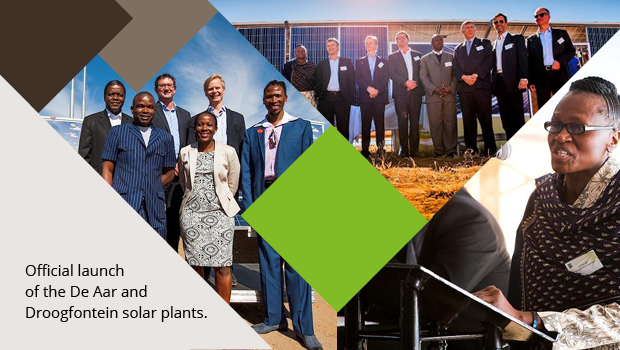Solar plants unveiled in Northern Cape
Thebe Investment Corporation was part of the celebrations marking the official inauguration of the Solar Power Project, which will supply clean, renewable electricity to Eskom’s national grid. Thebe is proud that these Solar Power plants will enable South Africa to reduce its carbon emissions by 34% in 2020 and 42% in 2025.
A consortium led by British company Globeleq officially launched the De Aar and Droogfontein solar photovoltaic plants, representing a combined investment of R3-billion, in the Northern Cape on the 16th May. Thebe Investment Corporation is a shareholder in the consortium and proud to be part of the shift towards renewable energy resources.
The De Aar and Droogfontein solar photovoltaic plants, each comprising over 165 000 photovoltaic (PV) panels spread over 100-hectare sites near De Aar and Kimberley, will together contribute 100 megawatts (MW) of clean energy to South Africa’s national grid. Both were built under the government’s renewable energy programme for independent power producers, which aims to add 3 725 MW of wind, solar photovoltaic and concentrating solar power to South Africa’s energy mix.
Vusi Khanyile, Chairman of Thebe Investment Corporation, described the project as a milestone in South Africa’s history. Speaking at the inauguration of the Droogfontein Solar Power project earlier in May, he said that electricity has been a scarce resource and this has manifested itself in the form of rolling blackouts, or the so-called load shedding, which has impacted our economy negatively.
“No economy can grow and industrialise without affordable and reliable power supply. We need electricity to keep the lights on and to power our mines, smelters, and factories. I believe that as more energy is added to our grid, South Africa will be in a better position to beneficiate its minerals, thereby helping our country to further re-industrialise its economy. As we further industrialise our economy, we will solve the problem of structural unemployment, which has proven to be an Achilles Heel for our young democracy,” he said.
As in all countries, there is a need to balance affordable, secure energy supply with a reduction in carbon emissions. The target is to supply about 18 000 megawatts of renewable power to the national electricity grid by 2030. This equates to roughly 17% of SA’s energy mix. The wind farms at Jeffreys Bay, and solar farms in De Aar and Droogfontein will make a significant contribution to the realisation of this target.
It is further estimated that renewable energy has the potential to create 130 000 new direct jobs by 2025 in the construction and installation, manufacturing, operations and maintenance of plant and equipment.
The South African renewable energy industry has also attracted significant investment. In 2012 alone, the industry attracted a total investment of $5.5 billion. “With many concessions the state is yet to award, there is no doubt that tens of billions will flow into the industry in years to come, as the state ramps up the procurement of renewable energy to meet its targets and obligations,” says Vusi.
Although it is still early days, all indications show that the South African Government Renewable Energy Independent Power Producer Procurement Programme (REIPPPP) is a success and hopefully South African’s energy shortage will be something of the past in the foreseeable future.


